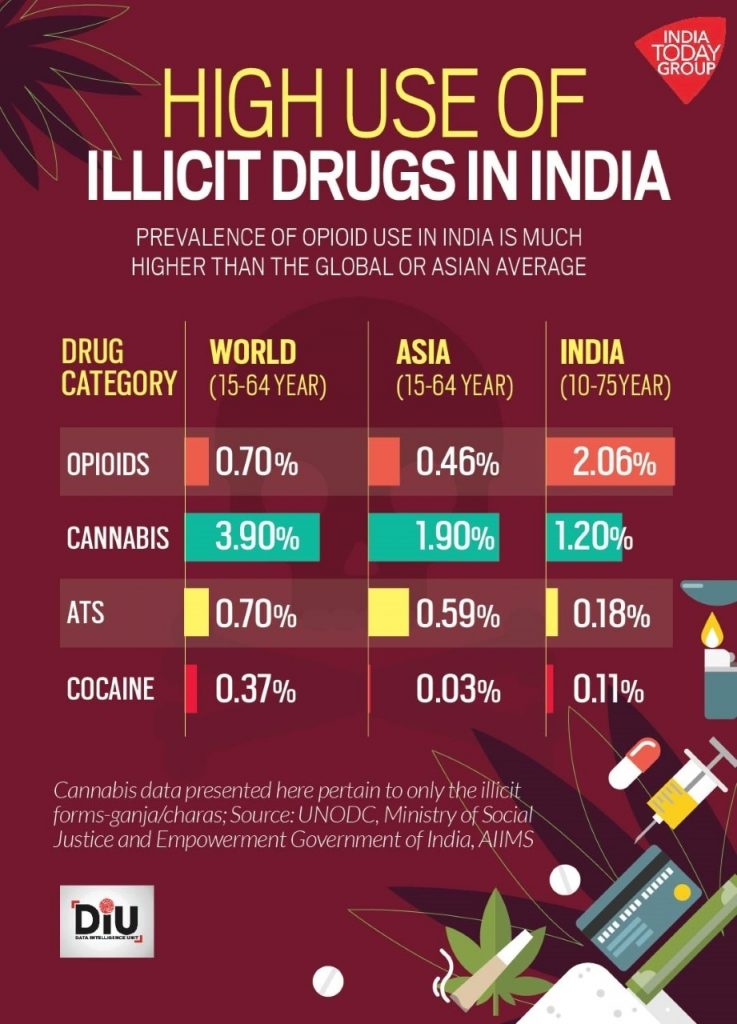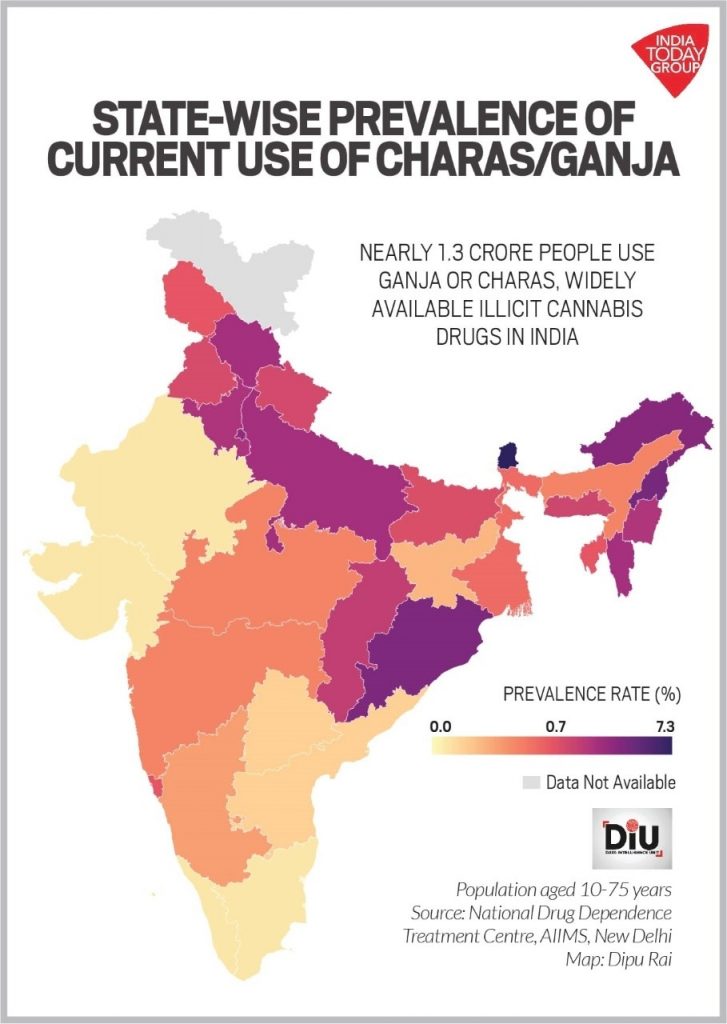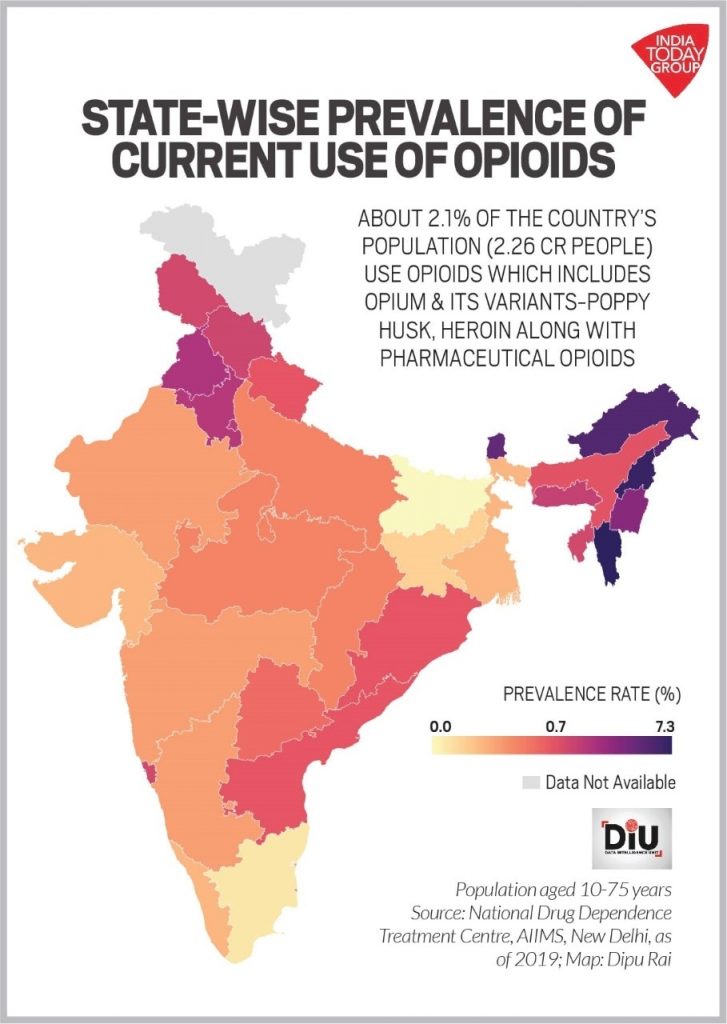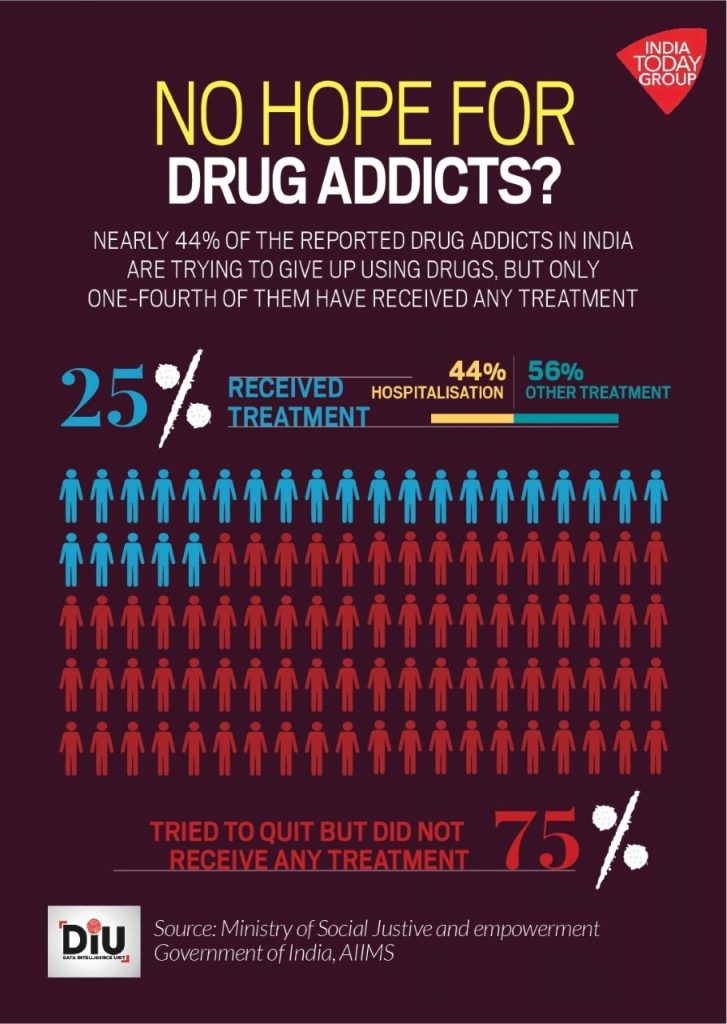Contents
- India and 26 bilateral pacts to fight drug trafficking
- New Initiatives in Building Energy Efficiency 2021
- Geospatial Technologies in Water Sector by NMCG
- Extreme weather events and climate change
India and 26 bilateral pacts to fight drug trafficking
Context:
According to a Ministry of Home Affairs (MHA) reply in the Lok Sabha – India has signed 26 bilateral pacts, 15 memoranda of understanding and two agreements on security cooperation with different countries for combating the drug trafficking problem.
Relevance:
GS-III: Internal Security Challenges (Organized Crime and Terrorism), GS-II: International Relations (Important International Agreements and Treaties affecting India’s Interests), GS-I: Indian Society, GS-II: Social Justice (Health related issues, Government Policies and Interventions)
Dimensions of the Article:
- Data on Drug Abuse problem in India: Report by AIIMS
- India’s Vulnerability
- Data Regarding Drug Abuse in the world
- Drug Abuse problem worsening due to Covid-19 Pandemic
- India’s International Coordination to fight Drug Abuse
- Narcotic Drugs and Psychotropic Substances Act, (NDPS)
- India’s Anti-Drug Action Plan for 2020-21
- Other Steps Taken in India
Data on Drug Abuse problem in India: Report by AIIMS
- In terms of users, India’s illicit drug markets are mostly dominated by cannabis and opioids. Alcohol is the most abused substance in India.
- The use of illegal cannabis in India is much lower than the global average – less than one-third. However, opioid use is three times higher than the worldwide average.
- Cannabis in the form of bhang is legal in India, whereas its other forms – ganja (marijuana) and charas (hashish) – are illegal. Opioids are sold as opium (doda, phukki or poppy husk), heroin (brown sugar, smack) and pharma opioids.
- India reported more than 2 crore opioid users in 2018, which was a five-fold jump in 14 years.
- The maximum growth was reported in consumption of heroin.
- India has more than 1 crore sedative users, the maximum number being in Uttar Pradesh, followed by Maharashtra, Punjab and Andhra Pradesh.
- Some drug users, relatively less in number, are taking the inhalational route and psychoactive drugs.
- Inhalants are the only drug category prevalent among children. More than 1% of children consume inhalants. Nearly 18 lakh adults and 4.6 lakh children are in the badly-addicted category.
- Cocaine is the less popular illicit drug in India with more than 10 lakh users. Being pretty expensive, it is mostly used by the well-off.
- Another drug category, hallucinogens, is used in limited circles, with over 12 lakh users in this category, of which one-third are in the harmful or dependent category.
- Findings show there are an estimated 8.5 lakh people who inject drugs (PWID) in India. Almost half of them inject heroin, while the same proportion is using injectable pharmaceutical opioids.




India’s Vulnerability
Golden crescent
- The Golden Crescent is the name given to one of Asia’s two principal areas of illicit Opium production, located at the crossroads of central, south and western Asia.
- This space overlaps three nations, Afghanistan, Iran and Pakistan whose mountainous peripheries define the crescent.
Golden triangle
- The Golden Triangle is located in the area where the borders of Thailand, Myanmar and Laos meet at the confluence of the Ruak and Mekong Rivers.
- Along with the Golden Crescent, it is regarded as one of the largest producers of opium in the world since the 1950s until it was overtaken by the Golden Crescent in the early 21st century.

Data Regarding Drug Abuse in the world
- One out of three drug users is a woman but women represent only one out of five people in treatment.
- People in prison settings, minorities, immigrants and displaced people also face barriers to treatment due to discrimination and stigma.
- Number of people using drugs in 2018 increased by 30% from 2009, with adolescents and young adults accounting for the largest share of users.
- While the increase reflects population growth and other factors, the data nevertheless indicate that illicit drugs are more diverse, more potent and more available.
- At the same time, more than 80% of the world’s population, mostly living in low- and middle-income countries, are deprived of access to controlled drugs for pain relief and other essential medical uses.

Drug Abuse problem worsening due to Covid-19 Pandemic
- The economic downturn caused by the global pandemic may drive more people to substance abuse or leave them vulnerable to involvement in drug trafficking and related crime.
- In the global recession that followed the 2008 financial crisis, drug users sought out cheaper synthetic substances and patterns of use shifted towards injecting drugs, while governments reduced budgets to deal with drug-related problems.
- All over the world, the risks and consequences of drug use are worsened by poverty, limited opportunities for education and jobs, stigma and social exclusion, which in turn helps to deepen inequalities, moving us further away from achieving the Sustainable Development Goals (SDGs).
India’s International Coordination to fight Drug Abuse
- The Narcotics Control Bureau (NCB) coordinated with various international organisations for sharing information and intelligence to combat transnational drug trafficking.
- The Various International Organizations that the NCB works with include:
- The SAARC Drug Offences Monitoring Desk; Brazil, Russia, India, China and South Africa (BRICS);
- Colombo Plan: A regional organisation of 27 countries designed to strengthen economic and social development of member countries in the Asia-Pacific region;
- Association of Southeast Asian Nations (ASEAN) and ASEAN Senior Officials on Drug Matters (ASOD);
- Bay of Bengal Initiative For Multi-Sectoral Technical and Economic Co-Operation (BIMSTEC);
- The United Nations Office on Drugs and Crime (UNODC);
- The International Narcotics Control Board (INCB).
- For coordination among various Central and State agencies, the Narco Coordination Centre (NCORD) mechanism was set up by the MHA in year 2016 for effective drug law enforcement. This NCORD system has been restructured into a four-tier scheme up to district level on July 29, 2019, for better coordination.
Narcotic Drugs and Psychotropic Substances Act, (NDPS)
- The Narcotic Drugs and Psychotropic Substances Act, 1985, commonly referred to as the NDPS Act prohibits a person the production/manufacturing/cultivation, possession, sale, purchasing, transport, storage, and/or consumption of any narcotic drug or psychotropic substance.
- India had no legislation regarding narcotics until 1985.
- The Act is designed to fulfill India’s treaty obligations under the Single Convention on Narcotic Drugs, Convention on Psychotropic Substances, and United Nations Convention Against Illicit Traffic in Narcotic Drugs and Psychotropic Substances.
- The Narcotics Control Bureau is a statutory body that was set up under the act with effect from 1986.
India’s Anti-Drug Action Plan for 2020-21
- The annual Anti-Drug Action Plan for 2020-21 for 272 districts was launched by the Ministry of Social Justice and Empowerment in June 2020.
- The action plan for 2020-21 included awareness generation programmes, identification of drug-dependent population, focus on treatment facilities and capacity-building for service-providers to curb drug abuse and alcoholism.
- De-addiction Facilities would be set up in the “most affected” 272 districts identified by the Narcotics Control Bureau focussing on building up treatment and de-addiction facilities and giving emphasis on reaching the youth and high-risk population.
- Integrated Rehabilitation Centre for Addicts (IRCAs) funded by the Ministry would reach out to communities to help those affected by drug addiction.
Other Steps Taken in India
- Narco-Coordination Centre (NCORD): Government had constituted Narco Coordination Centre (NCORD), the mechanism under Director General (DG), Narcotics Control Bureau (NCB), in order to have effective coordination among all the drug law enforcement agencies and other stakeholders, and also to provide a common platform for discussions on drug-trafficking related issues.
- National Fund for Control of Drug Abuse: The government has constituted a fund called “National Fund for Control of Drug Abuse” to meet the expenditure incurred in connection with combating illicit traffic in Narcotic Drugs; rehabilitating addicts, and educating the public against drug abuse, etc.
- Seizure Information Management System (SIMS): SIMS is a step taken towards digitization of pan-India drug seizure data in 2019 for all the drug law enforcement agencies under the mandate of Narcotics Drugs and Psychotropic Substances Act (NDPS). Narcotics Control Bureau (NCB) was provided with the funds for developing SIMS which will create a complete online database of drug offences and offenders.
-Source: The Hindu
New Initiatives in Building Energy Efficiency 2021
Context:
“Aiming for Sustainable Habitat: New Initiatives in Building Energy Efficiency 2021” was recently launched by the Bureau of Energy Efficiency (BEE) as part of ‘Azadi Ka Amrut Mahotsav’ to enhance energy efficiency in the building sector.
Relevance:
Prelims, GS-III: Environment and Ecology (Conservation of Environment, Pollution Control), GS-III: Industry and Infrastructure
Dimensions of the Article:
- Aiming for Sustainable Habitat: New Initiatives in Building Energy Efficiency 2021
- About the Bureau of Energy Efficiency (BEE)
- Objectives of BEE
Aiming for Sustainable Habitat: New Initiatives in Building Energy Efficiency 2021
- Eco Niwas Samhita 2021 is an Energy Conservation Building Code for Residential Buildings (ECBC-R) to give a further fillip to India’s energy conservation efforts. It specifies code compliance approaches and minimum energy performance requirements for building services, and verification framework with Eco Niwas Samhita 2021.
- A web-based platform called ‘The Handbook of Replicable Designs for Energy Efficient Residential Buildings’ was released as a learning tool, which can be used to create a pool of ready-to-use resources of replicable designs to construct energy-efficient homes in India.
- An Online Directory of Building Materials was released that would envisage the process of establishing standards for energy efficient building materials.
- National Energy Efficiency Roadmap for Movement towards Affordable & Natural Habitat (NEERMAN) Awards were announced to encourage exceptionally efficient building designs complying with BEE’s Energy Conservation Building Codes.
- An Online Star Rating Tool was launched that provides performance analysis to help professionals decide the best options to pick for energy-efficiency of their homes. It was launched for Energy Efficient Homes, created to improve energy-efficiency and reduce energy consumption in individual homes.
- It was also announced that there will be training provided for over 15,000 Architects, Engineers and Government officials on Energy Conservation Building Code (ECBC) 2017 and Eco Niwas Samhita 2021.
About the Bureau of Energy Efficiency (BEE)
- The Bureau of Energy Efficiency (BEE) is a statutory body under the Ministry of Power created in 2002.
- BEE is a statutory body as it was created under the provisions of the nation’s 2001 Energy Conservation Act.
- The agency’s function is to develop programs which will increase the conservation and efficient use of energy in India.
- The mission of Bureau of Energy Efficiency is to “institutionalise” energy efficiency services, enable delivery mechanisms in the country and provide leadership to energy efficiency in all sectors of the country.
- The primary objective would be to reduce energy intensity in the economy.
- The government has made it mandatory for certain appliances in India to have ratings by the BEE since 2010.
Objectives of BEE
- To exert leadership and provide policy recommendation and direction to national energy conservation and efficiency efforts and programs.
- To coordinate energy efficiency and conservation policies and programs and take it to the stakeholders
- To establish systems and procedures to measure, monitor and verify energy efficiency results in individual sectors as well as at a macro level.
- To leverage multi-lateral, bi-lateral, and private sector support in implementation of Energy Conservation Act and efficient use of energy and its conservation programs.
- To demonstrate delivery of energy efficiency services as mandated in the EC bill through private-public partnerships.
- To interpret, plan and manage energy conservation programs as envisaged in the Energy Conservation Act.
- To promote research and development in energy efficiency and energy conservation.
- To develop testing and certification procedures for energy consumption of equipment and appliances and promote the testing facilities.
- To strengthen consultancy services in the field of energy conservation.
-Source: PIB
Geospatial Technologies in Water Sector by NMCG
Context:
Director General of the National Mission for Clean Ganga (NMCG) released a detailed report on the opportunities in the Water sector that can benefit from the use of Geospatial technologies.
Relevance:
Prelims, GS-III: Science and Technology (Space Technology, Recent Developments in technology and their applications in daily life), GS-I: Geography (Water resource in India)
Dimensions of the Article:
- India’s water-woes
- What are geospatial technologies?
- Potential of Geospatial Technologies for the Water Sector in India
- National Mission for Clean Ganga (NMCG)
India’s water-woes
- According to the data provided by the Ministry of Water Resources (now Ministry of Jal Shakti) in 2017, average annual per capita water availability fell from more than 1800 cubic meters assessed in 2001 to just over 1500 cubic meters in 2011.
- The data also highlighted the possibility of average annual water availability per person reducing further to 1341 and 1140 in the years 2025 and 2050 respectively.
- The water availability of water stressed/water scarce regions of the country is much below the national average due to the high temporal and spatial variation of precipitation.
- According to the Global Annual Report, 2018 by the WaterAid, the water and sanitation advocacy group, India ranked at the top of 10 countries with lowest access to clean water close to home, with more than 16 crore people not having such access.
- According to a UNICEF Report in 2021, India has 4% of the world’s freshwater which has to cater to 17% of the world’s population.
- The UNICEF report of 2021 says that nearly 40% of the population in India will have absolutely no access to drinking water by 2030 and 6% of India’s GDP will be lost by 2050 due to the water crisis.
What are geospatial technologies?
- Geospatial is a term widely used to describe the combination of spatial software and analytical methods with terrestrial or geographic datasets. The term is often used in conjunction with geographic information systems and geomatics, never separately.
- “Geospatial technologies” is a term used to describe the range of modern tools contributing to the geographic mapping and analysis of the Earth and human societies.
- These technologies have been evolving in some form since the first maps were drawn in prehistoric times.
- In the 19th century, the long important schools of cartography and mapmaking were joined by aerial photography as early cameras were sent aloft on balloons and pigeons, and then on airplanes during the 20th century.
- The science and art of photographic interpretation and map making was accelerated during the Second World War and during the Cold War it took on new dimensions with the advent of satellites and computers.
- Satellites allowed images of the Earth’s surface and human activities therein with certain limitations.
- Computers allowed storage and transfer of imagery together with the development of associated digital software, maps, and data sets on socioeconomic and environmental phenomena, collectively called geographic information systems (GIS).
Potential of Geospatial Technologies for the Water Sector in India
- The Association of Geospatial Industries released a report titled “Potential of Geospatial Technologies for the Water Sector in India” which mentions opportunities in the Water sector that can benefit from the use of Geospatial technologies.
- Geospatial and digital technologies like Satellite Based Remote Sensing, GPS Based Equipment and Sensors, Artificial Intelligence, Big Data Analytics, Internet of Things, 5G, Robotics and Digital Twin, can be effectively used to combat the water crisis.
Way Forwards: Geospatial technology and Water usage
- In order to derive maximum benefit from geospatial technology implementation in various programmes, user departments need to build a long-term vision of the outcomes of geospatial implementation.
- An integrated collaborative platform to connect the data and technology used by various organizations need to be developed for seamless access to information both locally and nationally and enable decision making.
- Various datasets including demography, socio-cultural, economic, and other parameters need to be integrated with spatial and non-spatial data related to water, like soil moisture, annual rainfall, rivers, aquifer, groundwater levels, water quality etc.
- Agriculture sector use 80-85% of water resources, while have only about 30-35% efficiency of water use – so, Geospatial technologies can be used for increasing water use efficiency to at least 50%.
National Mission for Clean Ganga (NMCG)
- National Mission for Clean Ganga (NMCG) was registered as a society on under the Societies Registration Act 1860.
- The government had set up the Clean Ganga Fund in 2014 – Using the funded money to finance NMCG (National Mission for Clean Ganga 2011), cleaning the river, setting up Waste Treatment Plants, Conservation of river biodiversity and related R&D projects.
- NMCG is the implementation wing of National Council for Rejuvenation, Protection and Management of River Ganga (referred as National Ganga Council NGC).
- The NMCG now has the status of an Authority and its key focus would be maintaining required ecological flows in the Ganga, abate pollution through planning, financing and execution of programmes including that of –
- Augmentation of Sewerage Infrastructure
- Catchment Area Treatment
- Protection of Floodplains
- Creating Public Awareness
-Source: PIB
Extreme weather events and climate change
Context:
People around the world have been doubly hit by the Covid-19 pandemic and extreme weather events which experts say have been fuelled by climate change.
Relevance:
GS-III: Environment and Ecology (Climate Change and its Impact, Conservation of Environment, Effects of Environmental Pollution)
Dimensions of the Article:
- CEEW Study on Extreme Weather Events
- Extreme Weather events that coincided with the Pandemic
- Climate Change as a reason for increased Extreme Weather events
- Other Causes of Extreme Weather Events
CEEW Study on Extreme Weather Events
- A Study by Council on Energy, Environment and Water (CEEW) found that in the last 50 years, the frequency of flood events increased almost eight times.
- Over 75 per cent districts in India, home to more than 63.8 crore people, are hotspots of extreme climate events such as cyclones, floods, droughts, heat and cold waves.
- Events associated with floods such as landslides, heavy rainfall, hailstorms, thunderstorms, and cloudbursts increased by over 20 times.
- The frequency, intensity, and unpredictability of these extreme events have risen in recent decades – while India witnessed 250 extreme climate events in 35 years between 1970 and 2005, it recorded 310 such weather events in only 15 years since then.
- The frequency of floods surged significantly in the last two decades, it was found. – In 2019 alone, India witnessed 16 extreme flood events, which affected 151 districts. The study found that over 9.7 crore people are currently exposed to extreme floods in India.
- Six of India’s eight most flood-prone districts in the last decade—Barpeta, Darrang, Dhemaji, Goalpara, Golaghat, Sivasagar—are in Assam.
- India is already the fifth most vulnerable country globally in terms of extreme climate events, and it is all set to become the world’s flood capital.
- The CEEW analysis indicates that while the number of rainy days during monsoon have decreased, single-day extreme rainfall events are increasing, leading to flooding.
- According to the study, the yearly average of drought-affected districts increased 13 times after 2005.
- The study also found a shift in the pattern of extreme climate events, such as flood-prone areas becoming drought-prone and vice-versa, in over 40 per cent of Indian districts.

Extreme Weather events that coincided with the Pandemic
- Along with the pandemic, people across the world struggled to survive as they faced extreme weather in the form of storms, cyclones, heavy rainfall and record heat.
- Response and recovery to people hit by cyclones, storms and similar extreme weather was constrained throughout the pandemic in 2020.
- India experienced one of its wettest monsoons since 1994, with a seasonal surplus of 9% that led to severe floods and landslides.
- Cyclone Amphan, which hit Kolkata in May 2020, has been named as the costliest tropical cyclone for the North Indian Ocean region that brought about an estimated loss of USD 14 billion.
Climate Change as a reason for increased Extreme Weather events
- The world temperature has increased quite high from the past few decades and even keeps on changing year after year.
- One of the big reasons for the increase in Earth’s temperature is the level of CO2.
- As the CO2 is increasing in the atmosphere, the temperature of the earth is also increasing simultaneously.
- As the world temperature is increasing due to global warming simultaneously the effects of it are also increasing.
- Global warming is contributing to intensifying heatwaves.
- Global warming also boosts the amount of water vapor in the atmosphere which may lead to causes of severe weather like heavy rainfall, heavy snowstorm, etc.
Other Causes of Extreme Weather Events
- Extreme Temperature: The temperature of the Earth is rising every year and increasing temperature and extreme sunshine on top of it creates a low-pressure system – due to this the hurricanes and other tropical storms get their way to start.
- High Atmospheric Winds: The jet streams found where the cold air from Earth’s poles meets with warm tropical air help to continue and control the weather system from west to east in the northern hemisphere and from east to west in the southern hemisphere. Sometimes these winds bring unpleasant weather with them which may lead to the formation of a tornado.
- Meeting of Pressure systems: When too cold high-pressure systems meet with too warm low-pressure systems, the chances of extremely high waves on sea surface increases.
- Improper Weather Systems: The weather systems (such as air masses, fronts, etc.) keep on moving in a proper way which helps to maintain the weather conditions in a smoother way. When the weather conditions come across any disturbance in between, it creates disasters.
-Source: Indian Express




